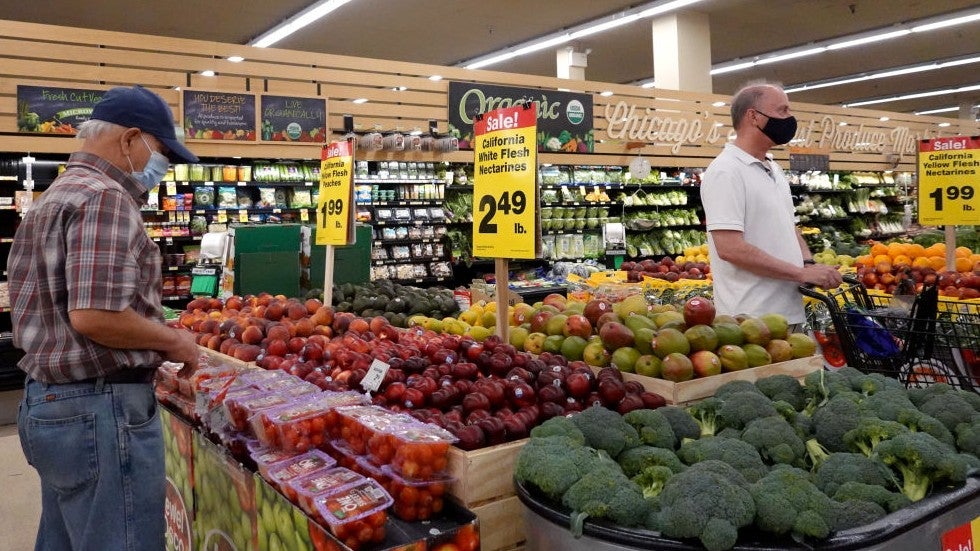Policymakers and investors are bracing for another jump in prices with new inflation figures for April set to be released Wednesday.
Economists expect the Labor Department’s consumer price index (CPI), a key gauge of inflation, to show prices rising roughly 8 percent over the past 12 months and 0.2 percent in April alone, according to consensus estimates. While the annual rate of price growth may drop slightly from the 8.5 percent clocked in March, prices are still likely to have risen on a month-over-month basis as inflation remains near four-decade highs.
Gregory Daco, chief economist at audit and consulting firm EY-Parthenon, said an April decline in gasoline prices from March peaks will likely bring the headline annual inflation number down from last month’s levels. Price growth in April will also look less extreme compared to April 2021 — when the inflationary spurt began — than compared to before the recovery kicked into gear in March 2021.
Even so, Daco said price growth for everything other than food and energy, which economists call core inflation, is expected to rise further amid the mass return to leisure and hospitality, housing, and medical services.
“Services, housing, and health care are three categories that will see upward pressures going forward, so paying close attention to them will help me assess how rapidly inflation is likely to cool or grow,” Daco said in a Tuesday interview.
“If they’re stronger or stronger than expected, that means that inflation is going to be stickier and persist for longer periods of time.”
Inflation began rising rapidly a year ago as an increasingly vaccinated US population returned to pre-pandemic spending patterns and activities. While consumer spending had recovered rapidly, thousands of businesses still faced trouble securing the workers, supplies and logistical support necessary to meet that demand. With far more money chasing goods and services in short supply, prices began to rise sharply.
“People tried to kind of return to consuming things the way they usually did starting around that summer,” said Alan Cole, former senior economist for the Joint Economic Committee.
“They found that the real capacity of the economy wasn’t always there to serve their needs, for several reasons.”
Consumers also spent a far greater share of their spending on manufactured goods than before the pandemic, which overloaded supply chains already struggling to recover from COVID-19. And they had far more money to spend after President Biden signed a $1.9 trillion stimulus bill in March 2021 — on top of the more than $4 trillion approved by former President Trump — and the Federal Reserve kept interest rates near zero until last month.
Both Biden and the Fed assured Americans inflation would cool off as the economy adapted to post-pandemic conditions. Scores of economists largely agreed, predicting prices would stop rising as fast once a combination of falling COVID-19 cases and rising labor force participation helped businesses meet the sharp jump in demand.
Twelve months later, both are struggling to make a dent in increasing prices across a much broader swath of the economy. With food, gas, shelter and health care prices on the rise, the White House and Fed are facing pressure over how they’ll bring inflation down — and how they let it get so high in the first place.
In a Wednesday speech, Biden called fighting inflation his top domestic priority and the biggest threat to an otherwise strong economic recovery. While the US has added more than 8 million jobs since Biden took office last year, high inflation has left a majority of Americans unhappy with his and the Democratic Party’s handling of the economy.
The president blamed high inflation on two primary factors: pandemic-related supply chain disruptions and the war in Ukraine. The outbreak of the war and the economic blowback from sanctions have led to drastic jumps in food and energy prices as soaring demand and the decimation of supplies from Russia and Ukraine create what the White House has called “the Putin price hike.”
Many economists, however, say the combination of unprecedented fiscal and monetary stimulus have also fueled at least some of the rapid inflation.
“The amount of money bouncing around the economy as a whole is just clearly above not just where it was in 2021 or 2020, but it’s above where we would have expected spending to be if none of this had ever happened,” Cole said.
“Right now both ideas are valid, and people who want to put it all on one or the other are, I think, trying to mislead or push an agenda.”
The Fed is also attempting to reassure financial markets it has to handle on inflation after waiting until last month to hike interest rates. Fed Chairman Jerome Powell and several top bank officials have acknowledged they should have begun hiking interest rates sooner and admitted it would be “very difficult” to tamp down on inflation without causing an economic slowdown.
“At this point, everyone, including current Fed officials, agrees they should have gotten going sooner. The expectation that the supply-side pressures would ease was overly optimistic,” said Claudia Sahm, a former Fed research director, in a Tuesday email.
